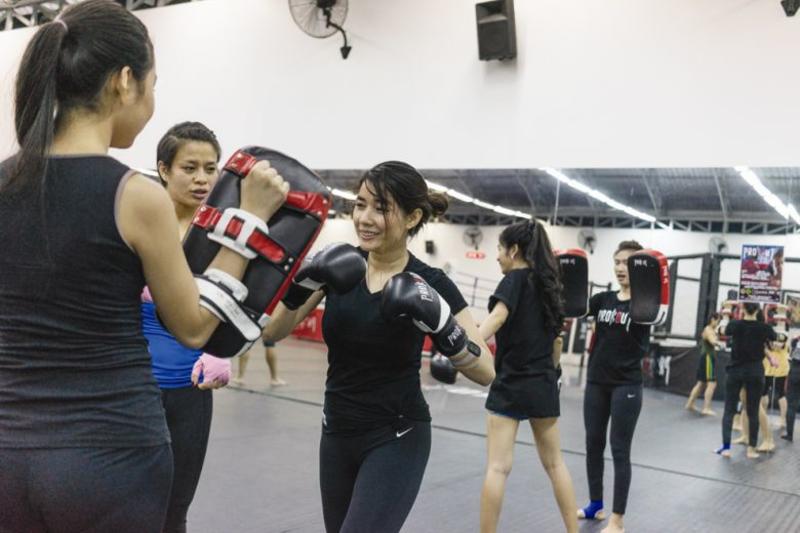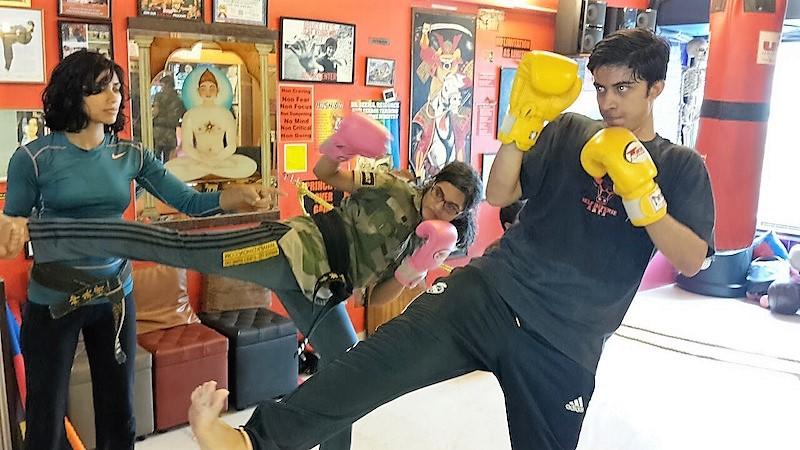Learn Muay Thai Kick boxing best certificate course of top ten martial arts class in Mumbai


Traditional Muay Thai practiced today uses kicks and punches in a ring with gloves similar to those used in Western Boxing. Muay Thai is referred to as “The Science of Eight Limbs”, as the hands, shins, elbows and knees are all used extensively in this art. Almost all techniques in Muay Thai use the entire body movement, rotating the hip with each kick, punch, and block. At CATS Mumbai we teach the art of Muay Thai in a systematic & scientific manner
GENERAL KNOWLEDGE
Muay Thai or literally Thai boxing is a combat sport of Thailand that uses stand-up striking along with various clinching techniques. This discipline is known as the “art of eight limbs” as it is characterized by the combined use of fists, elbows, knees, and shins.
Techniques
Muay Thai is often a fighting art of attrition, where opponents exchange blows with one another. Almost all techniques in Muay Thai use the entire body movement, rotating the hip with each kick, punch, elbow and block.
As a tactic, body punching is used less in Muay Thai than most other striking combat sports to avoid exposing the attacker’s head to counter strikes from knees or elbows. To learn Muay Thai contact our Mumbai center
Elbow (Sok)
The elbow can be used in several ways as a striking weapon: horizontal, diagonal-upwards, diagonal-downwards, uppercut, downward, backward-spinning and flying. Muay Thai Kick boxing ( Andheri Knock Out ) lays emphasis that The elbow strike is considered the most dangerous form of attack in the sport.
Elbows can be used to great effect as blocks or defenses against, for example, spring knees, side body knees, body kicks or punches. When well connected, an elbow strike can cause serious damage to the opponent, including cuts or even a knockout.
Kicking (Te)
The two most common kicks in Muay Thai are known as the thip (literally “foot jab”) and the te chiang (kicking upwards in the shape of a triangle cutting under the arm and ribs), or roundhouse kick. The Thai roundhouse kick uses a rotational movement of the entire body and has been widely adopted by practitioners of other combat sports. The roundhouse kick draws its power almost entirely from the rotational movement of the hips, counter-rotation of the shoulders and arms are also often used to add torque to the lower body and increase the power of the kick as well.
Knee (Ti Khao)
- Khao dot (Jumping knee strike) – the boxer jumps up on one leg and strikes with that leg’s knee.
- Khao loi (Flying knee strike) – the boxer takes a step(s), jumps forward and off one leg and strikes with that leg’s knee.
- Khao thon (Straight knee strike) – the boxer simply thrusts it forward but not upwards, unless he is holding an opponent’s head down in a clinch and intend to knee upwards into the face.
Foot-thrust (Thip)
The foot-thrust, or literally, “foot jab”, is one of the techniques in Muay Thai. It is mainly used as a defensive technique to control distance or block attacks. Foot-thrusts should be thrown quickly but with enough force to knock an opponent off balance.
Clinch and neck wrestling (Chap kho)
In Muay Thai, in the clinch where knee and elbow techniques are used. To strike and bind the opponent for both offensive and defensive purposes, small amounts of stand-up grappling are used in the clinch.
A correct clinch also involves the fighter’s forearms pressing against the opponent’s collar bone while the hands are around the opponent’s head rather than the opponent’s neck. The general way to get out of a clinch is to push the opponent’s head backward or elbow them, as the clinch requires both participants to be very close to one another.
Defense against attacks
Defenses in Muay Thai are categorized in six groups:
- Blocking – defender’s hard blocks to stop a strike in its path so preventing it reaching its target (e.g. the shin block described in more detail below)
- Parries – defender’s soft parries to change the direction of a strike (e.g. a downwards tap to a jab) so that it misses the target
- Avoidance – moving a body part out of the way or range of a strike so the defender remains in range for a counter-strike. For example, the defender moves their front leg backward to avoid the attacker’s low kick, then immediately counters with a roundhouse kick. Or the defender might lay their head back from the attacker’s high roundhouse kick then counter-attack with a side kick.
- Evasion – moving the body out of the way or range of a strike so the defender has to move close again to counter-attack, e.g. defender jumping laterally or back from attacker’s kicks
- Disruption – Pre-empting an attack e.g. with defender using disruptive techniques like jab, foot-thrust or low roundhouse kick, generally called a “leg kick”(to the outside or inside of the attacker’s front leg, just above the knee) as the attacker attempts to close distance
- Anticipation – Defender catching a strike (e.g. catching a roundhouse kick to the body) or countering it before it lands (e.g. defender’s low kick to the supporting leg below as the attacker initiates a high roundhouse kick). We teach this in our Mumbai center
Defenses in practice
Defensively, the concept of “wall of defense” is used, in which shoulders, arms and legs are used to hinder the attacker from successfully executing techniques. Blocking is a critical element in Muay Thai and compounds the level of conditioning a successful practitioner must possess. At CATS Mumbai we follow the scientific methodology of teaching Muay Thai
